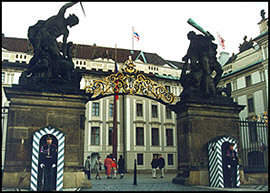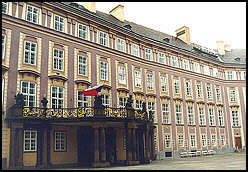 History History |
The arrival of the Slavs in the 5th and 6th centuries saw the beginning of the Czechs' chequered history. Its tribes adopted Christianity and united in the short-lived Great Moravian Empire (830-906), which came to include western Slovakia, Bohemia, Silesia, and parts of eastern Germany, south-eastern Poland and northern Hungary. Towards the end of the 9th century, the Czechs seceded to form the independent state of Bohemia.

Prague Castle was founded in the 870s by Prince Borivoj as the main seat of the Premysl dynasty, though the Premysls failed to unite the squabbling Czech tribes until 993. In 950, the German King Otto I conquered Bohemia and incorporated it into his Holy Roman Empire. In 1212, the pope granted the Premsyl prince Otakar I the right to rule as king. His son and successor Otakar II tried to claim the title of Holy Roman Emperor as well as king of the Czechs, but the imperial crown went to Rudolph Hapsburg. Strong rule under the Hapsburgs brought with it Bohemia's Golden Age. Prague grew into one of Europe's largest and most important cities, and was ornamented with fine Gothic landmarks.
The late 14th and early 15th centuries witnessed an influential Church-reform movement, the Hussite Revolution, led by the Czech Jan Zizka who was inspired by the teachings of Jan Hus. The spread of Hussitism had threatened the Catholic status quo all over Europe. In 1420 combined Hussite forces successfully defended Prague against the first of a series of anti-Hussite crusades, which had been launched by authority of the pope. Though they were up against larger and better equipped forces, the Hussites repeatedly went on the offensive and raided deep into Germany, Poland and Austria.
In 1526 the Czech kingdom again came under control of the Catholic Hapsburgs. On 23 May 1618, the Bohemian Estates, protesting against both the Hapsburgs' failure to deliver on promises of religious tolerance and the loss of their own privileges, ejected two Hapsburg councillors from an upper window of Prague Castle (they survived with minor injuries). This famous 'defenestration' sparked off the Thirty Years' War. The Czechs lost their rights and property, and almost their national identity, through forced Catholicisation and Germanisation, and their fate was sealed for the next three centuries.
In the 19th century, Bohemia and Moravia were swept by nationalistic sentiments. The Czech lands joined in the 1848 revolutions sweeping Europe, and Prague was the first city in the Austrian Empire to rise in favour of reform. The dream of an independent state began to be realised during WW I. Eventually Czechs and Slovaks agreed to form a single federal state of two equal republics. The First Republic initially experienced an industrial boom; however, slow development, the Great Depression, an influx of Czech bureaucrats and the breaking of a promise of a Slovak federal state, generated calls for Slovak autonomy.
Czechoslovakia was not left to solve its problems
in peace. Most of Bohemia's three-million German
speakers fell for the dream of a greater Germany,
Hitler demanded (and got) the Sudetenland in the
infamous Munich agreement of 1938 and the Czechs
prepared for war. Although Bohemia and Moravia suffered
little material damage in the war, many of the Czech
intelligentsia were killed and the Germans managed
to wipe out most of the Czech underground. Tens
of thousands of Czech and Slovak Jews perished in
concentration camps. On 5 May 1945, the population
of Prague rose against the German forces as the
Red Army approached from the east. The Germans,
granted free passage out of the city by the victorious
Czech resistance, began pulling out on 8 May. Most
of Prague was thus liberated before Soviet forces
arrived the following day. |
Czechoslovakia was re-established as an independent state. Attempts to consolidate its cultural identity - and punish its oppressors - included large scale deportations of German and Hungarian inhabitants. In the 1946 elections, the Communists became the largest party, with 36% of the popular vote. The 1950s was an era of harsh repression and decline as the Communist economic policies nearly bankrupted the country. Many people were imprisoned, and hundreds were executed or died in labour camps, often for little more than a belief in democracy. In the 1960s, Czechoslovakia enjoyed a gradual liberalisation. A new president, the former Slovak party leader Alexander Dubcek, represented a popular desire for full democracy and an end to censorship - 'socialism with a human face'. Soviet leaders, unable to face the thought of a democratic society within the Soviet bloc, crushed the short-lived 'Prague Spring' of 1968 with an invasion of Warsaw Pact troops on the night of 20-21 August. By the end of the next day, 58 people had died. In 1969, Dubcek was replaced and exiled to the Slovak forestry department. Around 14,000 party functionaries and 500,000 members who refused to renounce their belief in 'socialism with a human face' were expelled from the Party and lost their jobs. Totalitarian rule was re-established and dissidents were routinely imprisoned.
The Communist regime remained in control after the fall of the Berlin Wall in late 1989. But on 17 November things changed. Prague's Communist youth movement organised a demonstration in memory of nine students executed by Nazis in 1939. A peaceful crowd of 50,000 were cornered, some 500 were beaten by the police and about 100 arrested. The following days saw constant demonstrations, and leading dissidents, with Vaclav Havel at the forefront, formed an anti-Communist coalition which negotiated the government's resignation on 3 December. A 'Government of National Understanding' was formed, with the Communists as minority members. Havel was elected president of the republic on 29 December and Dubcek was elected speaker of the national assembly. The days after the 17 November demonstration have become known as the 'Velvet Revolution' because there were no casualties. (In September 1992 Dubcek was seriously injured in a car accident near Prague, dying of injuries on 7 November. Conspiracy theorists have been busy ever since.)

Voices for autonomy in Slovakia were getting stronger, and a vocal minority was demanding independence. Finally, it was decided by prime ministers of both republics and other leading politicians that splitting the country was the best solution. Many people, including President Havel, called for a referendum, but even a petition signed by a million Czechoslovaks was not enough for the federal parliament to agree on how to arrange it. In the end Havel resigned from his post, as after repeated attempts by the new parliament he was not re-elected as president. Thus, on 1 January 1993, Czechoslovakia ceased to exist for the second time this century. Prague became the capital of the new Czech Republic, and Havel was promptly elected its first president.
Thanks to stringent economic policies, booming tourism
and a solid industrial base, the Czech Republic
is seeing a strong recovery. Unemployment is negligible,
shops are full and many cities are getting facelifts.
The picture is not all rosy, however: there is an
acute shortage of affordable housing, steeply rising
crime, severe pollution and a deteriorating health
system. But the newly founded democracy and its
radical economic transformation seem to be working. |

